The Contribution of Energy-Optimized Urban Planning to Efficient Resource Use–A Case Study on Residential Settlement Development in Dhaka City, Bangladesh
Abstract
:1. Introduction
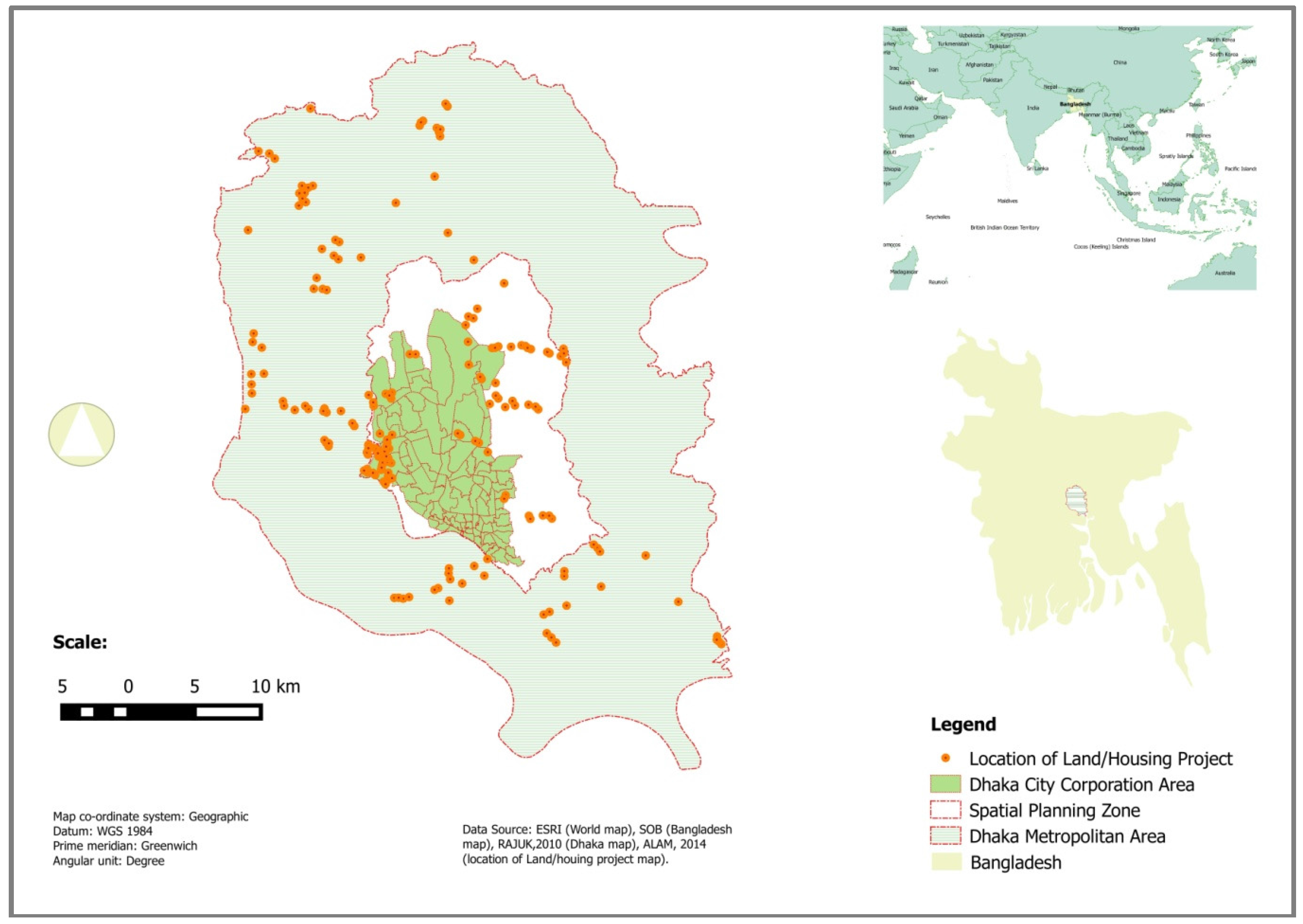
2. Background of Energy-optimized Urban Planning
3. Methodology
3.1. Conceptual Framework: The "EnUp" Model
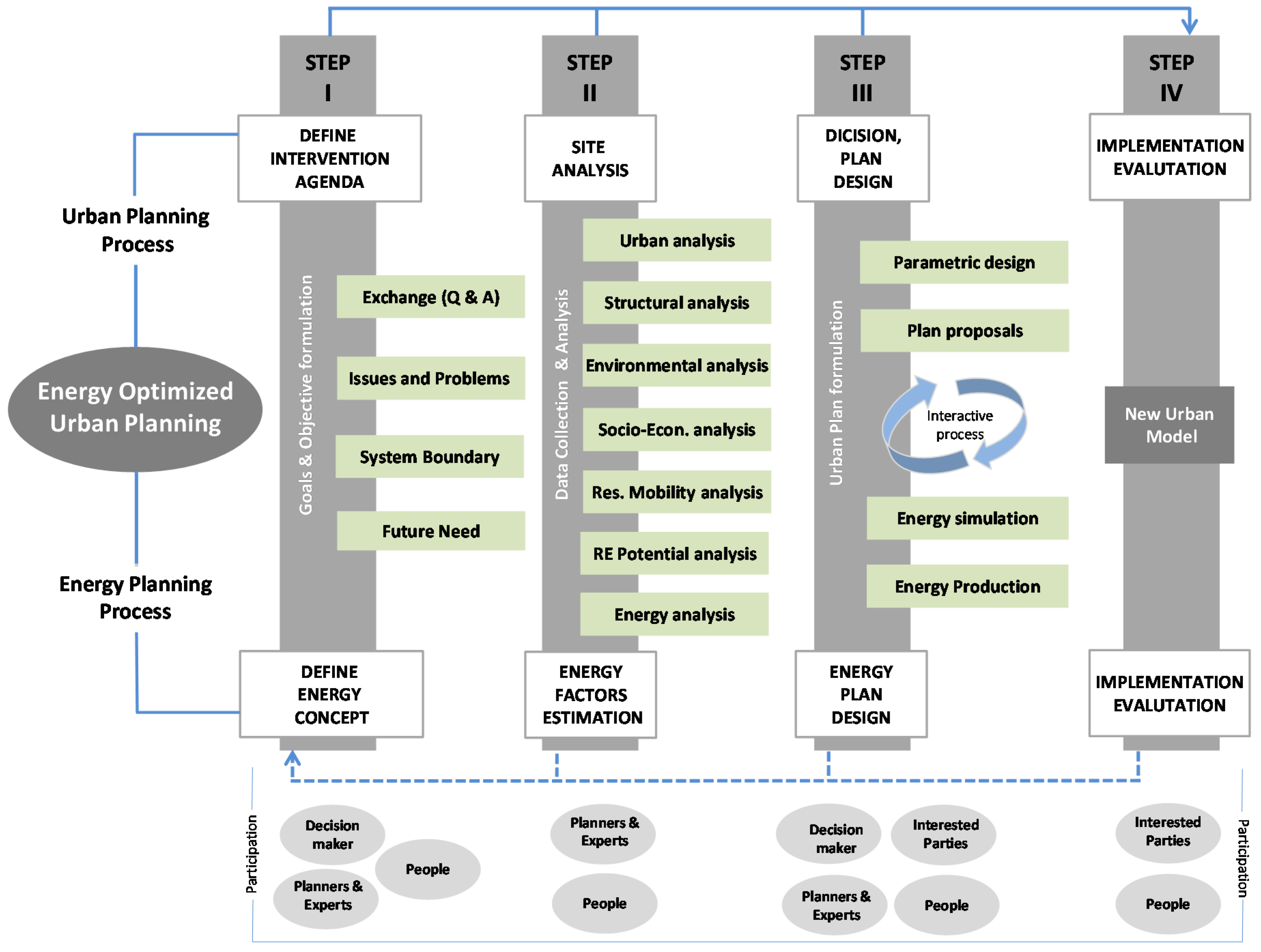
3.2. Assessment Method, Data Collection and Analysis
4. Results of Case Study
4.1. Current Status
4.1.1. Urban Planning and Development
4.1.2. Residential Settlement Development and Energy Concerns

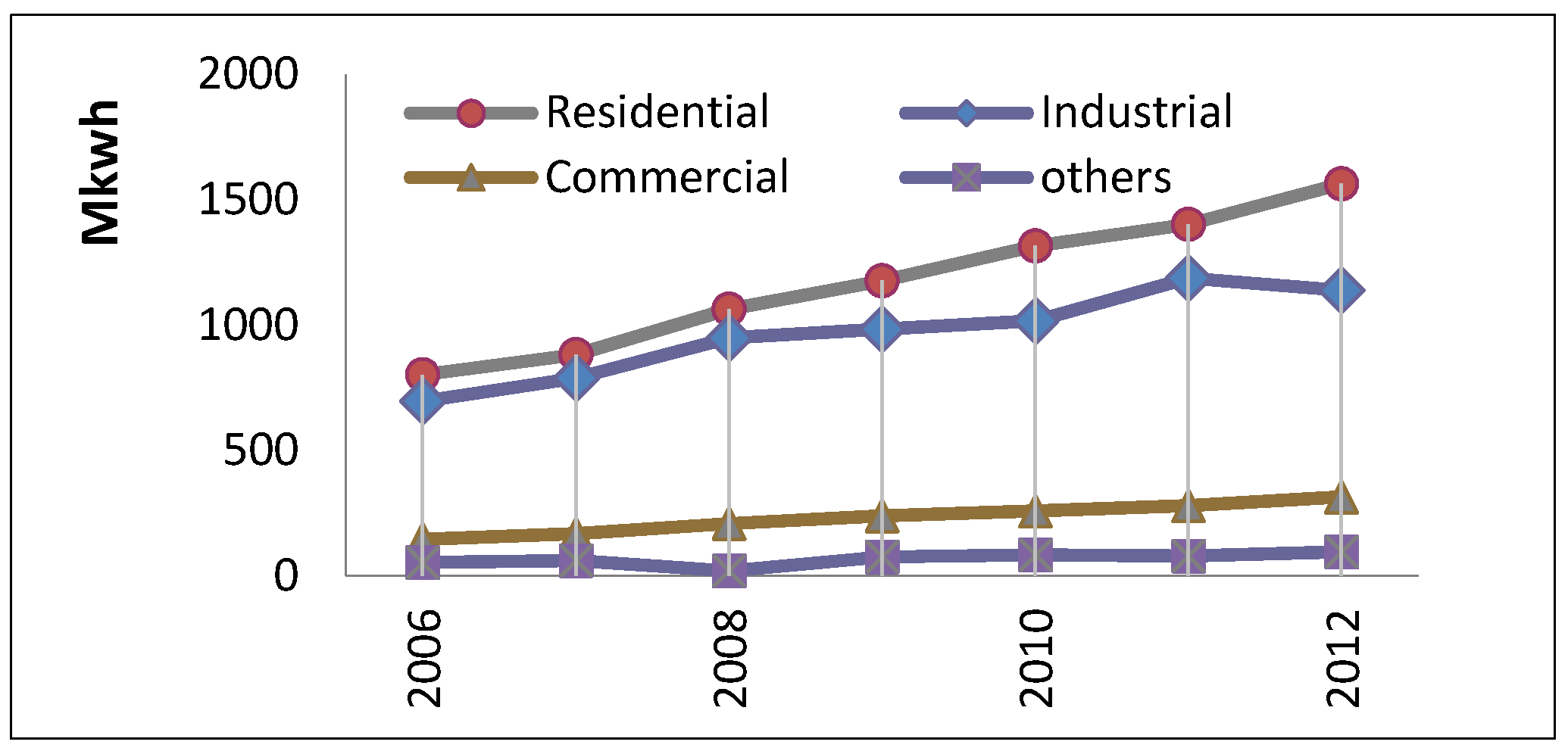
4.1.3. Actors Involved in Residential Settlement Development
| Sector/Agency | Applied Projects | Approved Projects |
|---|---|---|
| Electricity suppliers | No records | Information could not be collected |
| Transport Authority | No records | 02 |
| Gas suppliers | 20 | 06 |
| Department of Environment (DoE) | 27 | 02 |
| Dhaka city corporation | No record | 06 |
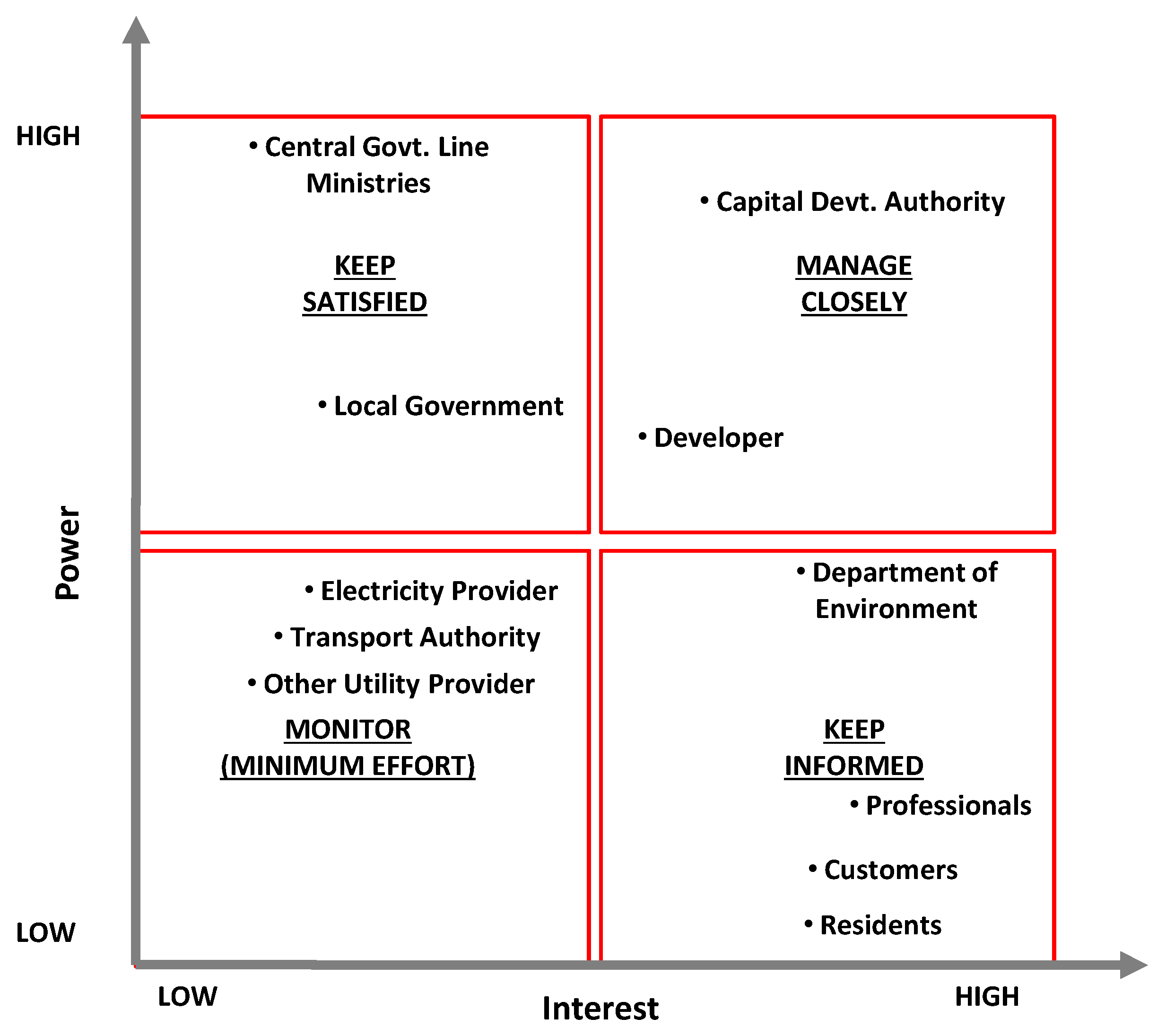
4.1.4. Regulatory Frameworks in Place
| Law/Policy and Enactment Year | Potential | Weakness |
|---|---|---|
| Town Improvement Act (TIA Act 1953) | Basis for building code and land use clearance | Prescribed land use enforcement is optimized in case of privately owned land |
| Dhaka Metropolitan Development Plan (1995–2005) | Identified suitable areas for residential settlement development | Lack of detailed guidelines and even created conflicts with other regulations; need to address energy parameters |
| Environmental Conservation Act, 1995 | Legal basis for environmental assessment at least for large scale residential settlement projects, the small scale project also should be realized | Mostly focused on industrial and transport pollution control; soft punishment of violation (<5 years imprisonment or fine <$1500 USD or both) |
| Private Housing Project Land Development Rule, 2004 | Focused on social, physical and environmental standards; Keep approval provision by several urban authorities including energy agencies and transport authority | Almost no provision of punishment imposed other than old legal provisions; Lack of common understanding among different urban stakeholders. No project has approved under this rule yet |
| Public–Private Partnership Flat Housing Policy (2008) on public vacant land | Encourage innovative solutions to control land supply, mobility and urban form | Increase gentrification and flood risk |
| Metropolitan Building Construction Rules, 2008 | Introduced FAR which to enhance environmental, social and aesthetic values | Limited focus on energy efficiency issue in terms of building design, material use and construction management |
| National Renewable Energy Policy, 2008 | Promote renewable energy with an objective to meet 5% of the total power demand by 2015 and 10% by 2020 | Urban sector has all most ignored whereas more focused on rural electrification |
| Real Estate Development and Management Act, 2010 | Basis to impose innovative energy related strategies as it is dealing with management of property transfer and registration | No punishment provision due to violation, no price control mechanism; No concerns about conservation of ecological sensitive area |
| National Green Building Code, 2012 | Instrument to reduce energy consumptions, water use and environmental impact by regulating building design and constructions | Still under consultation which subject to government approval; No significant punishment assigned for violation |
5. Results and Discussion
5.1. Potential of “EnUp" Model in the Context of Dhaka
5.1.1. State of Individual Planning Steps
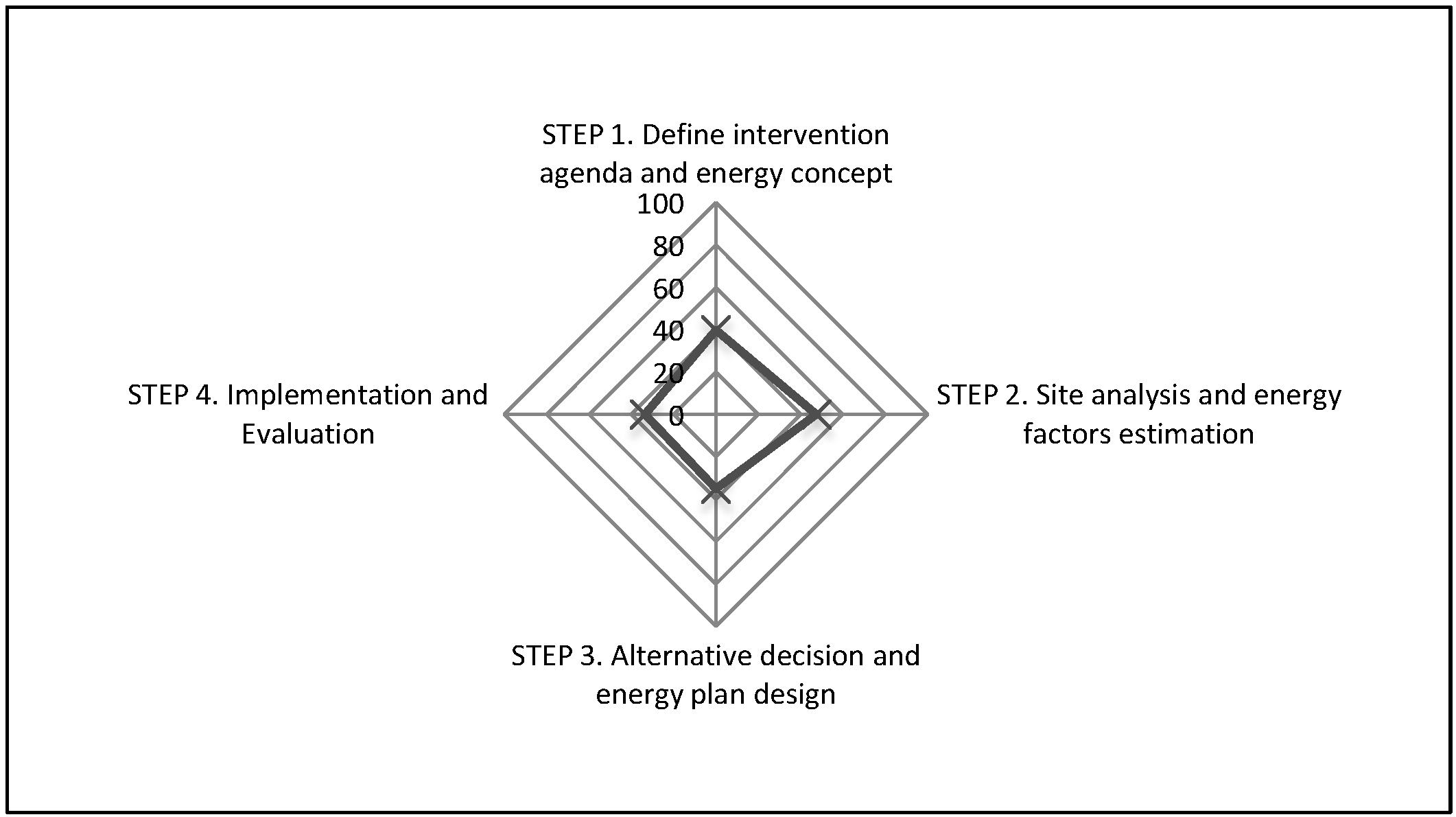
5.1.2. Methods, Models, and Tools that Work for the City
5.1.3. Challenges and Barriers

5.1.4. Where Further Efforts are Needed
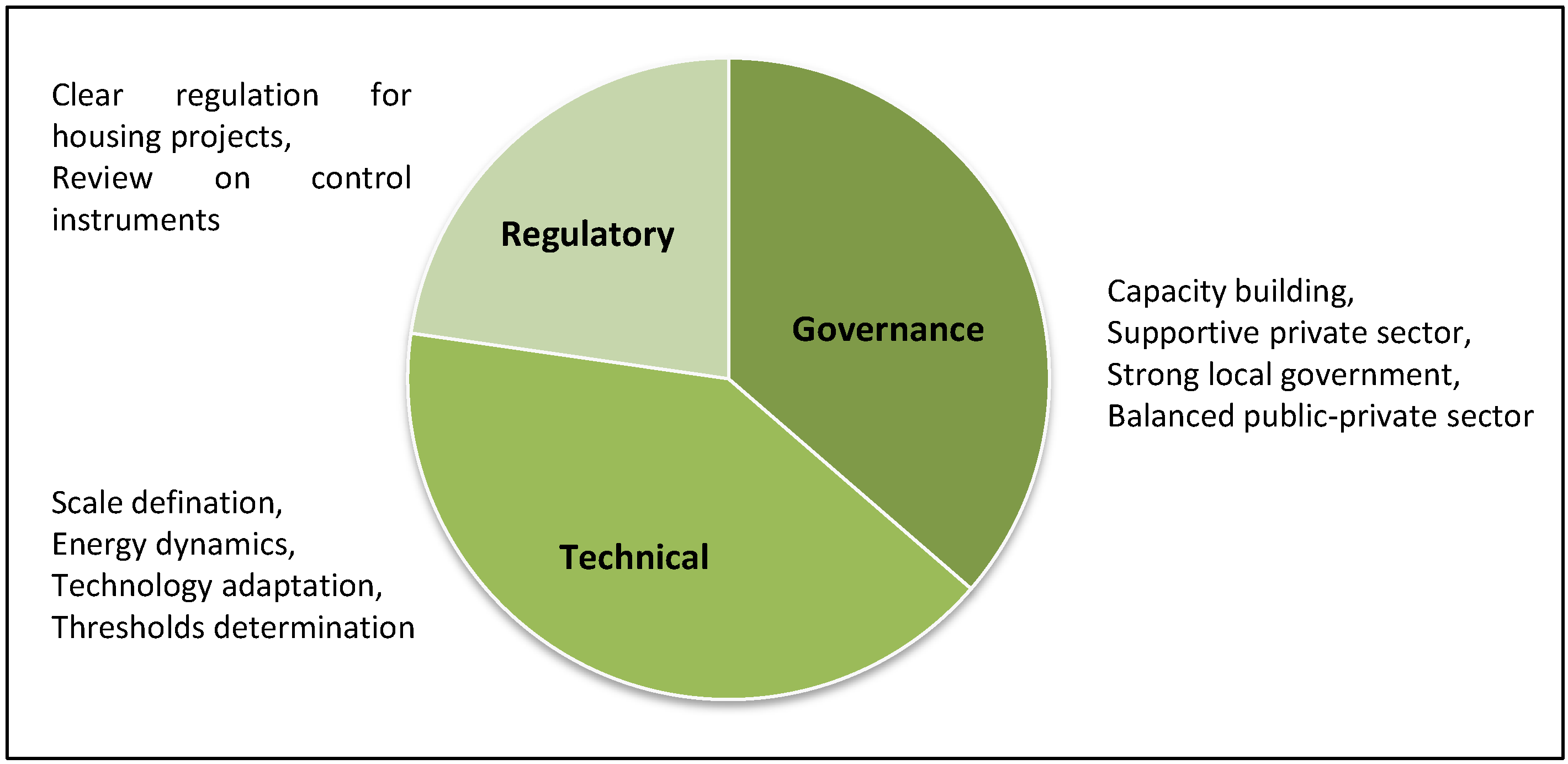
6. Conclusions and Policy Implications
Acknowledgments
Author Contributions
Conflicts of Interest
References
- Kanters, J.; Horvat, M. Solar Energy as a Design Parameter in Urban Planning. Energy Procedia 2012, 30, 1143–1152. [Google Scholar] [CrossRef]
- Lehmann, S. Can rapid urbanisation ever lead to low carbon cities? The case of Shanghai in comparison to Potsdamer Platz Berlin. Sustain. Cities Soc. 2012, 3, 1–12. [Google Scholar] [CrossRef]
- Duvarci, Y.; Kutluca, A.K. Appraisal of Energy Efficiency of Urban Development Plans: The Fidelity Concept on Iymir-Balcova case. Int. Schol. Sci. Res. Innov. 2008, 2, 250–266. [Google Scholar]
- Wilson, B. Urban Form and Residential Electricity Consumption: Evidence from Illinois, USA. Landsc. Urban Plan. 2013, 115, 62–71. [Google Scholar] [CrossRef]
- Hachem, C.; Fazio, P.; Athienitis, A. Solar Optimized Residential Neighborhoods: Evaluation and Design Methodology. Solar Energy 2013, 95, 42–64. [Google Scholar] [CrossRef]
- Strasser, H. Challenges on the Way to Energy Optimized Communities Challenges on the Way to Energy Optimized Communities. 2012. Available online: http://www.nachhaltigwirtschaften.at/hdz_pdf/events/20121003_ecbcs_annex51_experts_workshop_2_strasser.pdf (accessed on 12 November 2014).
- Kanie, N.; Abe, N.; Iguchi, M.; Yang, J.; Kabiri, N.; Kitamura, Y.; Mangagi, S.; Miyazawa, I.; Olsen, S.; Tasaki, T.; et al. Integration and Diffusion in Sustainable Development Goals: Learning from the Past, Looking into the Future. Sustainability 2014, 6, 1761–1775. [Google Scholar] [CrossRef]
- Herfray, G.; Vorger, E.; Peuportier, B. Life Cycle Assessment Applied to Urban Settlements and Urban Morphology Studies. Available online: http://www.chaire-eco-conception.org/en/content/71-life-cycle-assessment-applied-to-urban-settlements-and-urban-morphology-studies (accessed on 12 December 2013).
- Yeo, I.-A.; Yoon, S.-H.; Yee, J.-J. Development of an Environment and Energy Geographical Information System (E-GIS) Construction Model to Support Environmentally Friendly Urban Planning. Appl. Energy 2013, 104, 723–739. [Google Scholar] [CrossRef]
- Vermeulen, T.; Knopf-Lenoir, C.; Villon, P.; Beckers, B. Urban layout optimization framework to maximize direct solar irradiation. Comput. Environ. Urban Syst. 2015, 51, 1–12. [Google Scholar] [CrossRef]
- Amado, M.; Poggi, F. Towards Solar Urban Planning: A New Step for Better Energy Performance. Energy Procedia 2012, 30, 1261–1273. [Google Scholar] [CrossRef]
- Stoeglehner, G.; Niemetz, N.; Kettl, K.-H. Spatial Dimensions of Sustainable Energy Systems: New Visions for Integrated Spatial and Energy Planning. Energy Sustain. Soc. 2011. [Google Scholar] [CrossRef]
- EC. Thematic Strategy on the Urban Environment (COM(2004)60). Thematic Strategy on the Urban Environment. 2004. Available online: http://eur-lex.europa.eu/legal-content/EN/TXT/?uri=celex:52005DC0718 (accessed on 9 January 2014).
- Blanford, G. International Emissions Scenarios: The Role of Developing Country Participation Environment. In Proceedings of the Environment Advisory Meetings, San Diego, CA, USA, 17 March 2009.
- Intergovernmental Panel on Climate Change (IPCC). Climate Change 2007—Mitigation of Climate Change. 2007. Available online: http://www.cambridge.org/catalogue/catalogue.asp?isbn=9780521705981 (accessed on 9 October 2014).
- Harmeling, S. Global Climate Risk Index 2012. Available online: www.germanwatch.org/cri (accessed on 15 October 2012).
- Offer, G.; Meah, N.; Coke, A. Enabling a Transition to Low Carbon Economies in Developing Countries Case Study: Bangladesh. 2011. Available online: https://workspace.imperial.ac.uk/energyfutureslab/Public/2010-03-17-Bangladesh-028_EFL_v2.pdf (accessed 21 February 2014).
- Islam, M.T.; Shahir, S.A.; Uddin, T.M.I.; Saifullaha, Z. Current energy scenario and future prospect of renewable energy in Bangladesh. Renew. Sustain. Energy Rev. 2014, 39, 1074–1088. [Google Scholar] [CrossRef]
- Bangladesh Bureau of Statistics (BBS)-1. Energy statistics. In Statistical Years Book 2010; BBS: Dhaka, Bangladesh, 2011; p. 6. [Google Scholar]
- Ahamad, M.G.; Islam, N. Electricity consumption and economic growth nexus in Bangladesh: Revisited evidences. Energy Policy 2011, 39, 6145–6150. [Google Scholar] [CrossRef]
- Government of Bangladesh (GoB). Renewable Energy Policy of Bangladesh. 2008. Available online: http://www.powerdivision.gov.bd/pdf/REP_English.pdf (accessed on11 November 2013). [Google Scholar]
- Bangladesh Bureau of Statistics (BBS)-2. Population & Housing Census 2011: Preliminary Results. 2011. Available online: http://203.112.218.66/WebTestApplication/userfiles/Image/BBS/PHC2011Preliminary%20Result.pdf (accessed on 13 June 2013).
- Freestone, R. Learning from Planning Histories. In Urban Planning in a Changing World: the Twentieth Century Experience; Freestone, R., Ed.; Routledge: New York, NY, USA, 2000. [Google Scholar]
- Byrne, D. Complexity Theory and Planning Theory: A Necessary Encounter. Plan. Theory 2003, 2, 171–178. [Google Scholar] [CrossRef]
- Vandevyvere, H.; Stremke, S. Urban Planning for a Renewable Energy Future: Methodological Challenges and Opportunities from a Design Perspective. Sustainability 2012, 4, 1309–1328. [Google Scholar] [CrossRef]
- Webster, J. The Canadian Urban Archetypes Project: A Tool Facilitating the Integration of Energy-related Information into Urban Planning Decision Making. 2007. Available online: http://www.isocarp.net/data/case_studies/1087.pdf (accessed on 12 April 2012).
- Reiter, S.; Marique, A.-F. Toward Low Energy Cities. J. Ind. Ecol. 2012, 16, 829–838. [Google Scholar] [CrossRef]
- Daniell, K.; Sommerville, H.; Foley, B.; Maier, H.D.M. Integrated Urban System Modelling: Methodology and Case Study Using Multi-agent Systems. 2015. Available online: http://www.mssanz.org.au/modsim05/papers/daniell.pdf (accessed on 15 March 2014).
- Perez, P.; Batten, D.F. Sustainability Assessment of Housing Developments: A New Methodology. Available online: http://press.anu.edu.au/cs/html/ch07s03.html (accessed on 23 March 2014).
- Becker, T.; Boschert, S. Complex Urban Simulations and Sustainable Urban Planning with Spatial and Social Implications. 2013. Available online: http://www.isprs-ann-photogramm-remote-sens-spatial-inf-sci.net/II-2-W1/43/2013/isprsannals-II-2-W1-43%E2%80%932013.pdf (accessed on 18 September 2014).
- Mohanty, B. Sustainable Urban Energy–A Source Book for Asia; Barth, B., Cabrera, F., Rollnick, R., Eds.; United Nations Human Settlements Programme (UN HABITAT): Nairobi, Kenya, 2012. [Google Scholar]
- Hamedani, A.Z.; Huber, F. A Comparative Study of “DGNB” Certificate System in Urban Sustainability. Sustain. City 2012. [Google Scholar] [CrossRef]
- Pérez, M.G.R.; Rey, E. A Multi-criteria Approach to Compare Urban Renewal Scenarios for an Existing Neighborhood. Case Study in Lausanne (Switzerland). Build. Environ. 2013, 65, 58–70. [Google Scholar] [CrossRef]
- Sharifi, A.; Murayama, A. A Critical Review of Seven Selected Neighborhood Sustainability Assessment Tools. Environ. Impact Assess. Rev. 2013, 38, 73–87. [Google Scholar] [CrossRef]
- Sullivan, L.; Ridin, Y.; Buchanan, C. Neighbourhood Sustainability Frameworks–A Literature Review. 2014. Available online: https://www.ucl.ac.uk/usar/cdt/wps/USARWPS01-Sullivan-Neighbourhoods-PDF (accessed on 12 September 2014).
- Batty, M. Urban Modeling. In International Encyclopedia of Human Geography; Thrift, N., Kitchin, R., Eds.; Elsevier: Oxford, UK, 2009; pp. 51–58. [Google Scholar]
- Dosch, F.; Porsche, L. Rebuild the City! Towards Resource-efficient Urban Structures through the Use of Energy Concepts. In Adaptation to Climate Change, and Land Use Management; Mueller, B., Ed.; Springer: Heidelberg, Germany, 2010; pp. 35–45. [Google Scholar]
- Keirstead, J.; Samsatli, N.; Shah, N. SynCity: An Integrated Tool Kit for Urban Energy Systems Modelling. 2009. Available online: http://www.urs2009.net (accessed on 15 March 2014).
- REN21. Renewables Global Futures Report 2013. 2013. Available online: http://scholar.google.com/scholar?hl=en&btnG=Search&q=intitle:RenewableS+GLOBAL+FUTURES+REPORT+2013#1 (accessed on 30 October 2014).
- Mirakyan, A.; de Guio, R. Integrated Energy Planning in Cities and Territories: A Review of Methods and Tools. Renew. Sustain. Energy Rev. 2013, 22, 289–297. [Google Scholar] [CrossRef]
- Stevanović, S. Optimization of Passive Solar Design Strategies: A Review. Renew. Sustain. Energy Rev. 2013, 25, 177–196. [Google Scholar] [CrossRef]
- Niemeijer, D.; Groot, R.S. Framing Environmental Indicators: Moving from Causal Chains to Causal Networks. Environ. Dev. Sustain. 2008, 10, 89–106. [Google Scholar] [CrossRef]
- ICLEI, UN-Habitat. Sustainable Urban Energy Planning: A Handbook for Cities and Towns. 2009. Available online: http://www.uncsd2012.org/content/documents/Sustainable%20Urban%20Energy%20Planning.pdf (accessed on 21 January 2016).
- Todoc, J.L. Integrating Energy in Urban Planning in the Philippines and Vietnam. In Urban Energy Transition: From Fossil Fuels to Renewable Power; Droege, P., Ed.; Elsevier: Amsterdam, Netherlands, 2008; pp. 507–531. [Google Scholar]
- Rad, F. Application of Local Energy Indicators in Municipal Energy Planning: A New Approach Towards Sustainability. 2010. Available online: http://www.ees.energy.lth.se/fileadmin/ees/Publikationer/2010/ACEEE-2010-FDR (accessed on 10 October 2014).
- Beeck, N. A New Decision Support Method for Local Energy Planning. Ph.D. Thesis, Tilburg University, Warandelaan, The Nehterlands, June 2003. [Google Scholar]
- Huang, Z.; Yu, H.; Peng, Z.; Zhao, M. Methods and tools for community energy planning: A review. Renew. Sustain. Energy Rev. 2015, 42, 1335–1348. [Google Scholar] [CrossRef]
- González, A.; Donnelly, A.; Jones, M.; Chrysoulakis, N.; Lopes, M. A Decision-support System for Sustainable Urban Metabolism in Europe. Environ. Impact Assess. Rev. 2013, 38, 109–119. [Google Scholar] [CrossRef]
- Schetke, S.; Haase, D.; Kötter, T. Towards Sustainable Urban Land Use—A Methodological Design for Implementing Socio-Ecological Targets into the Strategic Planning of Cities in Germany Towards Sustainable Urban Land Use–A Methodological Design for Implementing Socio-Ecological Targets. In Proceedings of the XXIV FIG International Congress, Sydney, Australia, 11–16 April 2010.
- EU. Energy Solutions for Smart Cities and Communities Sustainable Energy Solutions for communities in countries. 2014. Available online: http://smartcities-infosystem.eu/sites/default/files/concerto_files/concerto_publications/2014–03_concerto-premium_lessons-learnt_sez_en.pdf (accessed on 14 January 2015).
- Knigge, L.; Cope, M. Grounded visualization: integrating the analysis of qualitative and quantitative data through grounded theory and visualization. Environ. Plan. A 2006, 38, 2021–2037. [Google Scholar] [CrossRef]
- Moffatt, S.; Suzuki, H.; Liyuka, R. Eco2 Cities Guide: Ecological Cities as Economic Cities; The world Bank: Washington, DC, USA, 2012. [Google Scholar]
- Bangladesh Bureau of Statistics (BBS)-3. Area, Population, Household and Household Characteristics. In Statistical Years Book 2010; BBS: Dhaka, Bangladesh, 2011; p. 2. [Google Scholar]
- Kabir, A.; Parolin, B. Planning and Development of Dhaka—A Story of 400 Years. In Proceedings of the15th International Planning History Society Conference, Sao Paulo, Brazil, 15–18 July 2012.
- Capital Development Authority (RAJUK). Rajuk’s Planning and Development Activities and Conservation Measures for the Lakes and Success Stories from Dhaka. 2013. Available online: http://cseindia.org/userfiles/RAJUK_Presentation_August72011.pdf (accessed on 12 March 2014).
- Kötter, P.T. Risks and Opportunities of Urbanisation and Megacities. In Proceedings of the FIG Working Week 2004, Athens, Greece, 22–27 May 2004.
- Nahrin, K. Violation of Land Use Plan and Its Impact on Community Life in Dhaka City. Jahangirnagar Plan. Rev. 2008, 6, 39–48. [Google Scholar]
- Parveen, R. Potentiality of Energy-plus Urban Developments in Developing Countries. Case Study: Dhaka, Bangladesh. 2012. Available online: http://anzasca.net/2012papers/papers/p60.pdf (accessed on 16 September 2013).
- Masum, F. Land Management Actors and Processes Behind Urban Fringe Development: Mechanism to Guide Urban Land Management. Study on Dhaka, Bangladesh. 2009. Available online: http://d-nb.info/995057648/34 (accessed on 18 August 2012).
- Alam, M.J. The Organized Encroachment of Land Developers—Effects on Urban Flood Management in Greater Dhaka, Bangladesh. Sustain. Cities Soc. 2014, 10, 49–58. [Google Scholar] [CrossRef]
- Real Estate and Housing Association of Bangladesh (REHAB). A Comprehensive Study on the Real Estate Sector of Bangladesh. 2012. Available online: http://www.rehab-bd.org/rehab_new_Comprehensive_Study_On_The_Real_Estate_Sector_Of_Bangladesh.pdf (accessed on 17 December 2012).
- Nilufar, P.F. Urban Morphology of Dhaka City: Spatial Dynamics of Growing City and the Urban Core. In Proceedings of International Seminar Proceedings on the Celebration of 400 Years of the Capital Dhaka, Asiatic Society, Dhaka, Bangladesh, 17–19 February 2010.
- Capital Development Authority (RAJUK). Preparation of Detailed Area Plan (DAP) for DMDP. 2010. Available online: https://www.rajukdhaka.gov.bd/rajuk/image/dap/.../Chapters_10.pdf (accessed on 8 May 2012). [Google Scholar]
- Ahsan, T. Passive Design Features for Energy-Efficient Residential Buildings in Tropical Climates: The context of Dhaka, Bangladesh. Master’s Thesis, KTH, Stockholm, Sweden, 2009. [Google Scholar]
- Dhaka Electric Supply Company Limited (DESCO). Annual Report 2012. 2012. Available online: https://www.desco.org.bd/uploads/attachments/Annual_Report_2012_reduced.pdf (accessed on 3 March 2014).
- Kabir, M.H.; Endlicher, W.; Jägermeyr, J. Calculation of Bright Roof-tops for Solar PV Applications in Dhaka Megacity, Bangladesh. Renew. Energy 2010, 35, 1760–1764. [Google Scholar] [CrossRef]
- Rahman, M.S.-U.; Timms, P.; Montgomery, F. Integrating BRT Systems with Rickshaws in Developing Cities to Promote Energy Efficient Travel. Procedia-Soc. Behav. Sci. 2012, 54, 261–274. [Google Scholar] [CrossRef]
- Mahmud, A. Management of Growth and Planned Development of Dhaka City: The Necessity of Proper Enforcement of Planning Standards.Bangladesh Institute of Planner Pubulication Series on Urbanization in Bangladesh, Dhaka, Bangladesh. 2006. Available online: http://www.bip.org.bd/SharingFiles/journal_book/20130718115951.pdf (accessed on 5 June 2012).
- Energy City. Urban Energy Models-Action Report. 2013. Available online: http://www.energycity2013.eu/pages/contact.php (accessed on 27 July 2013).
- Yamagata, Y.; Seya, H. Simulating a Future Smart City: An Integrated Land Use-energy Model. Appl. Energy 2013, 112, 1466–1474. [Google Scholar] [CrossRef]
- Institute for Building Efficiency. Green Building Rating Systems: Bangladesh. 2013. Available online: http://www.institutebe.com/ (accessed on 14 May 2014).
© 2016 by the authors; licensee MDPI, Basel, Switzerland. This article is an open access article distributed under the terms and conditions of the Creative Commons by Attribution (CC-BY) license (http://creativecommons.org/licenses/by/4.0/).
Share and Cite
Sikder, S.K.; Eanes, F.; Asmelash, H.B.; Kar, S.; Koetter, T. The Contribution of Energy-Optimized Urban Planning to Efficient Resource Use–A Case Study on Residential Settlement Development in Dhaka City, Bangladesh. Sustainability 2016, 8, 119. https://doi.org/10.3390/su8020119
Sikder SK, Eanes F, Asmelash HB, Kar S, Koetter T. The Contribution of Energy-Optimized Urban Planning to Efficient Resource Use–A Case Study on Residential Settlement Development in Dhaka City, Bangladesh. Sustainability. 2016; 8(2):119. https://doi.org/10.3390/su8020119
Chicago/Turabian StyleSikder, Sujit Kumar, Francis Eanes, Henok Birhanu Asmelash, Shiba Kar, and Theo Koetter. 2016. "The Contribution of Energy-Optimized Urban Planning to Efficient Resource Use–A Case Study on Residential Settlement Development in Dhaka City, Bangladesh" Sustainability 8, no. 2: 119. https://doi.org/10.3390/su8020119
APA StyleSikder, S. K., Eanes, F., Asmelash, H. B., Kar, S., & Koetter, T. (2016). The Contribution of Energy-Optimized Urban Planning to Efficient Resource Use–A Case Study on Residential Settlement Development in Dhaka City, Bangladesh. Sustainability, 8(2), 119. https://doi.org/10.3390/su8020119





